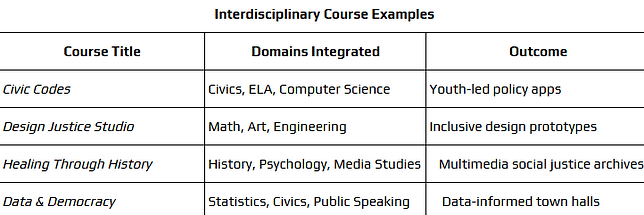Our Curriculum

Acadmeic Profeciency
We incorporate project-based learning, mentorship programs, and extracurricular
activities that align with students’ strengths, ensuring that every learner feels valued and
motivated to reach their full potential. We have designed a comprehensive curriculum
that aims to foster and enhance each student’s unique skills and talents. Our curriculum
offers a diverse range of hands-on activities, individualized learning pathways, and
support systems designed to accommodate various learning styles and needs. Our
focus promotes critical thinking, creativity, and collaboration, as well as business and
marketing skills, and provides opportunities for students to explore their interests in
depth.
Assessing Student Performance
Our unique grading system will assess the individual growth of each student as opposed to a
One-size-fits-all grading scale that does not show how far a student has come from a previous
low starting position. Instead, our progress reporting system will measure individual student
growth. Their latest test scores will be compared to their previous performance scores. The
changes will be measured in increments of 0-10 percentage points. For example, if a student’s
previous score was 47% and the current score is 54%, EHJLA will use the *Kenny Growth
Measure to show how much the student is growing as opposed to how close he is to achieving a passing grade between 70% to 100%.
*The Kenny Growth Metric uses data that shows proficiency in growth in numbers or
characteristics of the quality of student work.
Student Placement
EHJLA employs a sliding scale that assigns students to reading and math classes based on their academic performance levels rather than their grade levels. For instance, a sixth grader who performs at a ninth-grade level in math will be placed in a ninth-grade math class. However, all other subjects will be taught at the student's respective grade level, which in this case is sixth grade.
Teacher Application
Teachers will use SA2IMto bring the outside world into the classroom. This model was
developed by our curriculum analyst and our team of experts and has received an accreditation
rating that exceeds 31 points above the national norms when applied in previous learning
situations.
Teachers use SA²IM to bring the outside world into the classroom, thereby providing lessons With rigor and excitement that motivate students and drive their interest in social studies based
on current events and active learning experiences. The students put knowledge into practice by offering community solutions to often unmet needs.
The SAIIM model was implemented using the inquiry-based, interdisciplinary approach, along
with a teaching technique called reverse-chronology. Whenever possible, the written activities
from the K-12 SL Project Planning Toolkit, tests, and other supplemental materials were
included.
SA²IM embeds social-emotional intelligence, cultural fluency, and systems thinking across every subject area. Key Features:
Humanities: Students explore themes like identity, power, resistance, and community
through diverse texts and collaborative inquiry.
Project-Based Learning (PBL). All students engage in PBL cycles that center real-
world problem solving, community engagement, and interdisciplinary exploration.
Quarterly Projects include:
o Reimagine the City: Urban planning and equity through geometry and civics.
o Food Justice Now: Analyzing access to nutrition with biology and local advocacy.
Assessment culminates in community exhibitions and progress monitoring throughout the school year. This includes an entry exam, followed by a mid-term and exit exam, weekly quizzes, end-of-year exams, teacher-student interviews, digital portfolios, and reflective critiques.
Components include:
Application of leadership and team-building skills
Strength-based learning profiles
Social-emotional benchmarks
College /future goal setting
Pathways to college, workforce, or entrepreneurship
Interdisciplinary Course Examples
Future-Focused Readiness
EHJLA prepares students for world influence through:
-Students conduct individual service projects aimed at improving their communities.
-Digital Literacy + AI Fluency programs
-Community Research Fellowships
-Financial Literacy + Entrepreneurship Labs
Objectives & Impact
EHJLA learners strive to:
-Score well above state averages in core subjects.
-Graduate with digital portfolios, micro-credentials, and civic endorsements.
-Lead in community organizing, innovation challenges, and early college or vocational programs.
Conclusion
The Edward Horace Johnson Leadership Academy curriculum is not just about standards —
It’s about transformation. With SA2IM, PBL, a Sliding Proficiency Scale, and personalized
pathways to success, EHJLA redefines what middle and high school can be: a launchpad for
empowered, informed, and inspired leadership.



